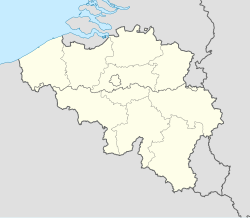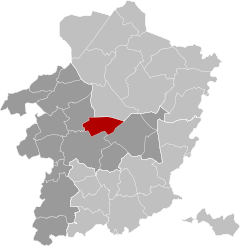
Limburg, also known as Belgian Limburg, is a province in Belgium. It is the easternmost of the five Dutch-speaking provinces that together form the Region of Flanders, which is one of the three main political and cultural sub-divisions of modern-day Belgium. As of January 2024, Limburg had a population of 0.9 million.

Beersel is a municipality in the province of Flemish Brabant, in the Flemish region of Belgium, 12 kilometres (7.5 mi) south-west of the centre of Brussels. The municipality comprises the towns of Alsemberg, Beersel proper, Dworp, Huizingen and Lot. On 1 January 2023, Beersel had a total population of 26.473. The total area is 30.01 km2 (11.59 sq mi), which gives a population density of 856/km2 (2,220/sq mi).

Hasselt is the capital and largest city of the province of Limburg in the Flemish Region of Belgium.
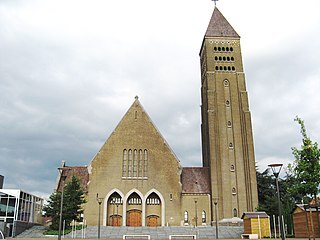
Genk is a city and municipality located in the Belgian province of Limburg near Hasselt. The municipality only comprises the town of Genk itself. It is one of the most important industrial towns in Flanders, located on the Albert Canal, between Antwerp and Liège.

Sint-Truiden is a city and municipality located in the province of Limburg, Flemish Region, Belgium, and has over 41,500 inhabitants, which makes it one of the largest cities in Limburg. The municipality includes the former communes of Aalst, Brustem, Duras, Engelmanshoven, Gelinden, Gorsem, Groot-Gelmen, Halmaal, Kerkom-bij-Sint-Truiden, Melveren, Metsteren, Ordingen, Runkelen, Velm, Wilderen, and Zepperen.

Alken is a municipality located in Belgian province of Limburg. The community lies just south of the provincial capital of Hasselt, in the Hesbaye region. Alken has about 11,300 residents, which gives the village a larger population than the nearby small cities of Borgloon and Herk-de-Stad.
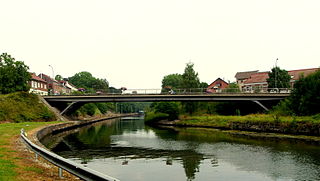
Lanaken is a municipality located in the Belgian province of Limburg. On January 1, 2007, the municipality of Lanaken had a total population of 24,724. Its area is 59.00 km2 which gives a population density of 415 inhabitants per km2.

La Louvière is a city and municipality of Wallonia located in the province of Hainaut, Belgium.

Houffalize is a city and municipality of Wallonia located in the province of Luxembourg, Belgium.

Durbuy is a city and municipality of Wallonia located in the province of Luxembourg, Belgium.
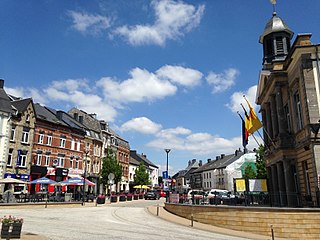
Neufchâteau is a city and municipality of Wallonia located in the province of Luxembourg, Belgium.

Sittard is a city in the Netherlands, situated in the southernmost province of Limburg.

Limburgish refers to a group of South Low Franconian varieties spoken in Belgium and the Netherlands, characterized by their distance to, and limited participation in the formation of, Standard Dutch. In the Dutch province of Limburg, all dialects have been given regional language status, including those comprising ″Limburgish″ as used in this article.

The Campine or Kempen is a natural region situated chiefly in north-eastern Belgium and parts of the south-eastern Netherlands which once consisted mainly of extensive moors, tracts of sandy heath, and wetlands. It encompasses a large northern and eastern portion of Antwerp Province and adjacent parts of Limburg in Belgium, as well as portions of the Dutch province of North Brabant and Dutch Limburg around Weert.

The Arrondissement of Maaseik is one of the three administrative arrondissements in the Province of Limburg, Belgium. It is not a judicial arrondissement. The municipalities of Bocholt, Bree, Kinrooi, Meeuwen-Gruitrode, Dilsen-Stokkem and Maaseik, are part of the Judicial Arrondissement of Tongeren, while the rest of its municipalities are part of the Judicial Arrondissement of Hasselt.

The Arrondissement of Hasselt is one of the three administrative arrondissements in the Province of Limburg, Belgium.

Maastricht railway station is located in Maastricht in Limburg, Netherlands. It is the main railway station in Limburg's capital city. It is the southern terminus of the Alkmaar–Maastricht intercity service by NS. Additionally, Arriva and the Belgian NMBS serve the station with local trains.

Kiewit is a Belgian parish and village within the northernmost extension of the Flemish municipality of Hasselt. It also borders on the municipality of Zonhoven to the north and Genk to the east, with Kuringen, another part of Hasselt, to the west.

Vogelsanck Castle is a moated castle in Zolder in the municipality of Heusden-Zolder, province of Limburg, Belgium.
Smeets is a brand of Hasselt jenever. In the past it was also the name of a distillery in the Belgian town of Hasselt. This distillery was founded in 1923 by Gerard Smeets (1894-1966). Nowadays, Smeets' jenever is produced by La Martiniquaise Benelux.




